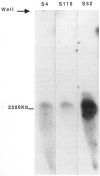Abstract
Evidence from linkage studies suggests that familial Alzheimer disease (AD) can be caused by a defect in a gene on the proximal long arm of chromosome 21. We have constructed a physical map spanning 10 megabases of this region of the chromosome by means of pulsed-field gel electrophoresis and analysis of somatic cell hybrids. Our data have allowed us to establish the order of chromosome 21 loci--cen-(S16,S48)-S13-S46-S4-(S52,S110)-(S1,S1 1)--and are thus of immediate relevance both to multipoint linkage analysis in families affected by AD and for moving from this linkage to the isolation of the genetic defect. We have also been able to identify several CpG-rich sequences close to the four most centromeric loci, suggesting the location of genes in this region. These probes, which are all within 1.5 megabases of one another, are currently the markers most tightly linked to the AD locus. Genes identified in this region can therefore be considered as candidates for the disease locus.
Full text
PDF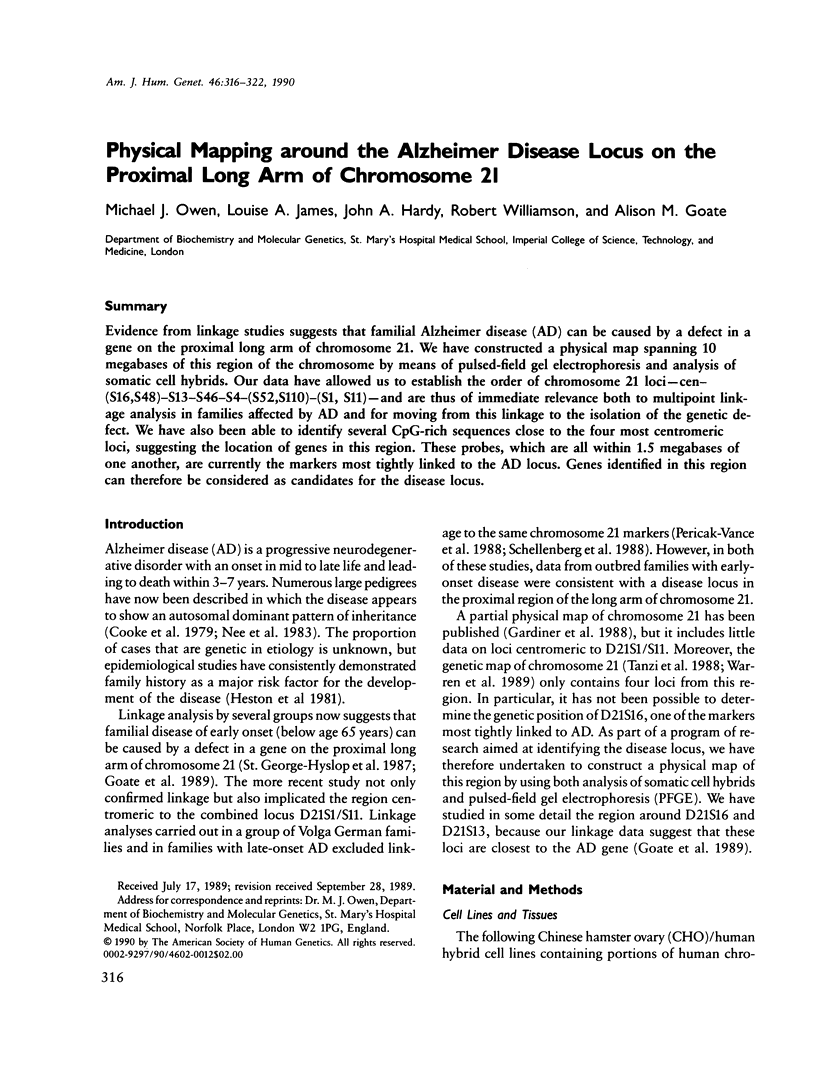

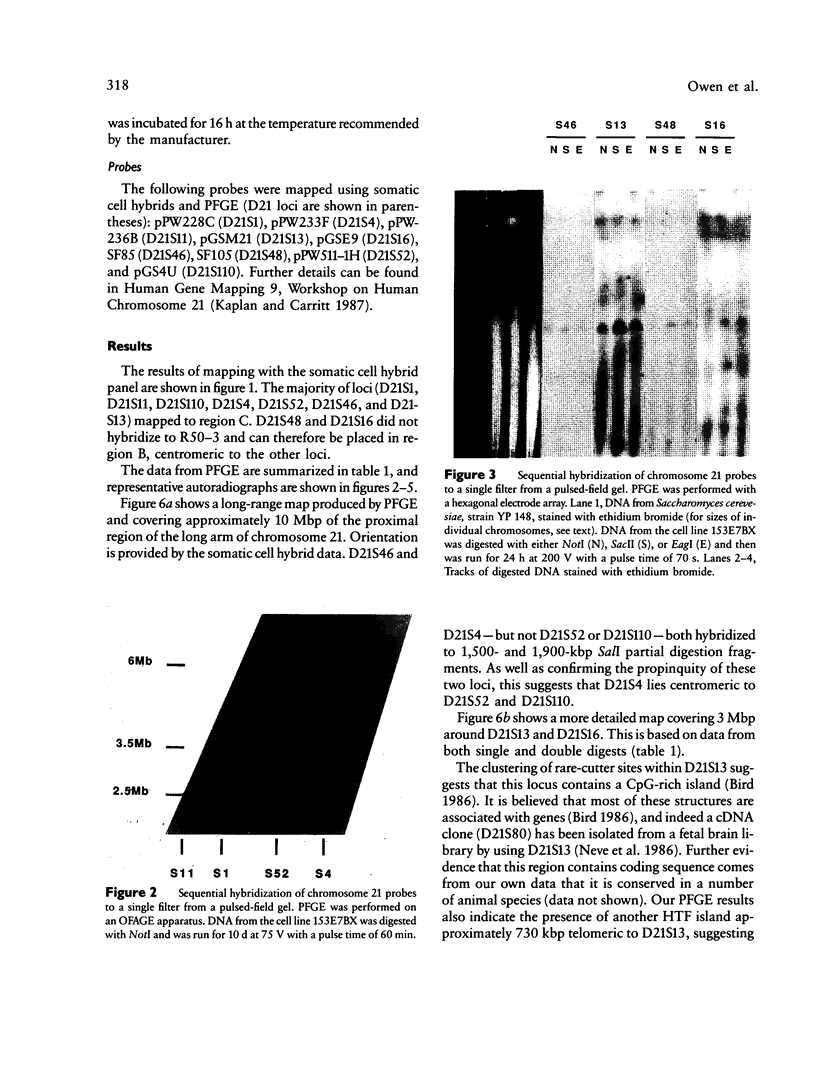
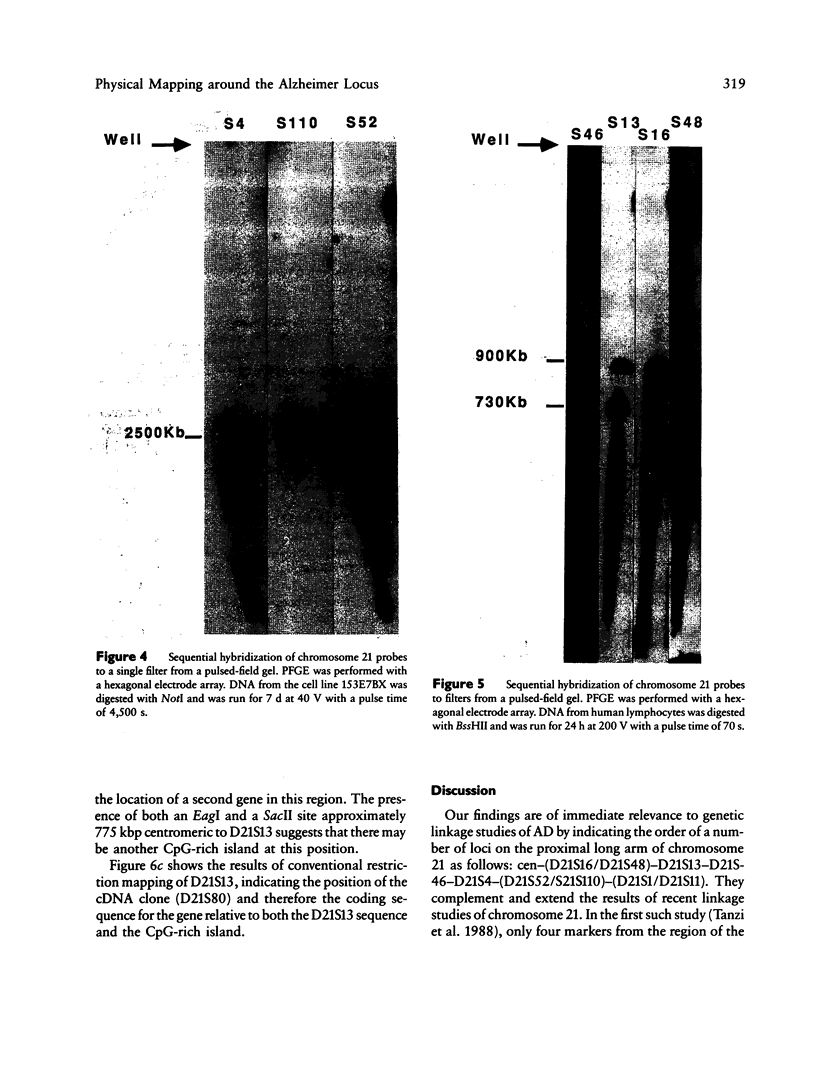
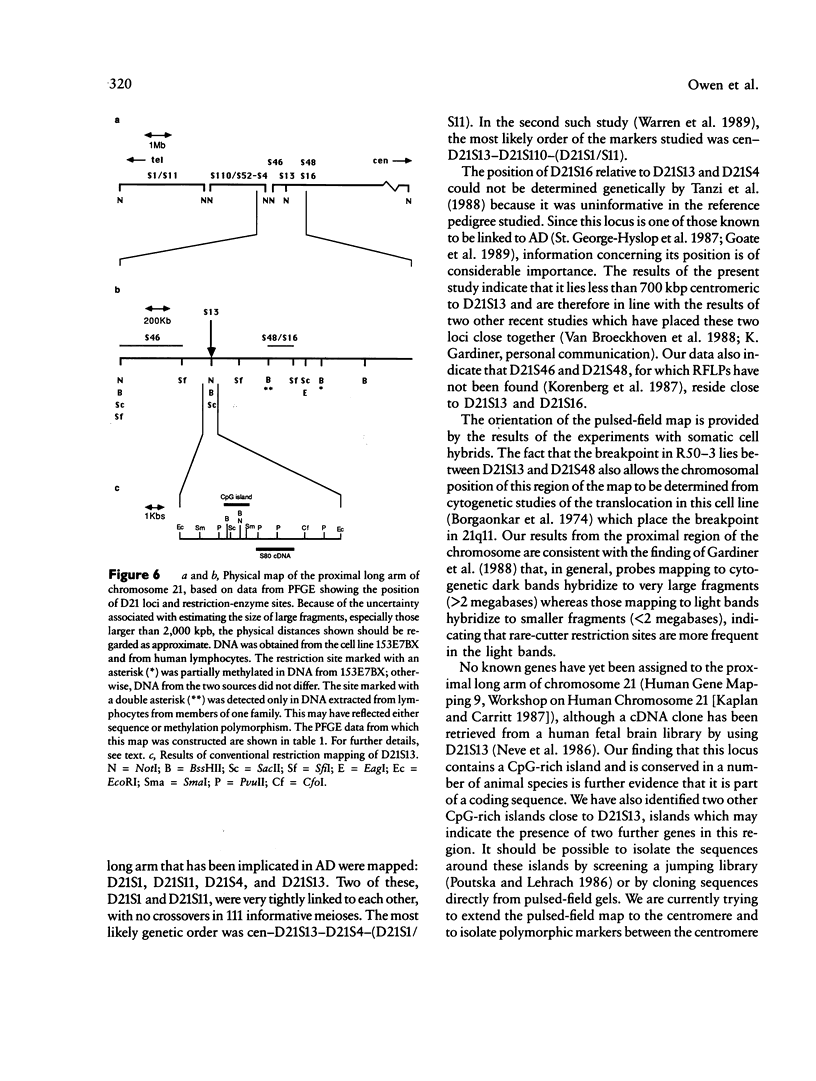


Images in this article
Selected References
These references are in PubMed. This may not be the complete list of references from this article.
- Bird A. P. CpG-rich islands and the function of DNA methylation. Nature. 1986 May 15;321(6067):209–213. doi: 10.1038/321209a0. [DOI] [PubMed] [Google Scholar]
- Borgaonkar D. S., Greene A. E., Coriell L. L. A (6;21) translocation, unbalanced, 46 chromosomes. Repository identification no. GM-144. Cytogenet Cell Genet. 1974;13(4):403–405. doi: 10.1159/000130290. [DOI] [PubMed] [Google Scholar]
- Burmeister M., Monaco A. P., Gillard E. F., van Ommen G. J., Affara N. A., Ferguson-Smith M. A., Kunkel L. M., Lehrach H. A 10-megabase physical map of human Xp21, including the Duchenne muscular dystrophy gene. Genomics. 1988 Apr;2(3):189–202. doi: 10.1016/0888-7543(88)90002-x. [DOI] [PubMed] [Google Scholar]
- Church G. M., Gilbert W. Genomic sequencing. Proc Natl Acad Sci U S A. 1984 Apr;81(7):1991–1995. doi: 10.1073/pnas.81.7.1991. [DOI] [PMC free article] [PubMed] [Google Scholar]
- Cook R. H., Ward B. E., Austin J. H. Studies in aging of the brain: IV. Familial Alzheimer disease: Relation to transmissible dementia, aneuploidy, and microtubular defects. Neurology. 1979 Oct;29(10):1402–1412. doi: 10.1212/wnl.29.10.1402. [DOI] [PubMed] [Google Scholar]
- Feinberg A. P., Vogelstein B. A technique for radiolabeling DNA restriction endonuclease fragments to high specific activity. Anal Biochem. 1983 Jul 1;132(1):6–13. doi: 10.1016/0003-2697(83)90418-9. [DOI] [PubMed] [Google Scholar]
- Goate A. M., Haynes A. R., Owen M. J., Farrall M., James L. A., Lai L. Y., Mullan M. J., Roques P., Rossor M. N., Williamson R. Predisposing locus for Alzheimer's disease on chromosome 21. Lancet. 1989 Feb 18;1(8634):352–355. doi: 10.1016/s0140-6736(89)91725-x. [DOI] [PubMed] [Google Scholar]
- Herrmann B. G., Barlow D. P., Lehrach H. A large inverted duplication allows homologous recombination between chromosomes heterozygous for the proximal t complex inversion. Cell. 1987 Mar 13;48(5):813–825. doi: 10.1016/0092-8674(87)90078-x. [DOI] [PubMed] [Google Scholar]
- Heston L. L., Mastri A. R., Anderson V. E., White J. Dementia of the Alzheimer type. Clinical genetics, natural history, and associated conditions. Arch Gen Psychiatry. 1981 Oct;38(10):1085–1090. doi: 10.1001/archpsyc.1981.01780350019001. [DOI] [PubMed] [Google Scholar]
- Korenberg J. R., Croyle M. L., Cox D. R. Isolation and regional mapping of DNA sequences unique to human chromosome 21. Am J Hum Genet. 1987 Dec;41(6):963–978. [PMC free article] [PubMed] [Google Scholar]
- Nee L. E., Polinsky R. J., Eldridge R., Weingartner H., Smallberg S., Ebert M. A family with histologically confirmed Alzheimer's disease. Arch Neurol. 1983 Apr;40(4):203–208. doi: 10.1001/archneur.1983.04050040033004. [DOI] [PubMed] [Google Scholar]
- Neve R. L., Stewart G. D., Newcomb P., Van Keuren M. L., Patterson D., Drabkin H. A., Kurnit D. M. Human chromosome 21-encoded cDNA clones. Gene. 1986;49(3):361–369. doi: 10.1016/0378-1119(86)90372-0. [DOI] [PubMed] [Google Scholar]
- Oates D. C., Patterson D. Biochemical genetics of Chinese hamster cell mutants with deviant purine metabolism: characterization of Chinese hamster cell mutants defective in phosphoribosylpyrophosphate amidotransferase and phosphoribosylglycinamide synthetase and an examination of alternatives to the first step of purine biosynthesis. Somatic Cell Genet. 1977 Nov;3(6):561–577. doi: 10.1007/BF01539066. [DOI] [PubMed] [Google Scholar]
- Pericak-Vance M. A., Yamaoka L. H., Haynes C. S., Speer M. C., Haines J. L., Gaskell P. C., Hung W. Y., Clark C. M., Heyman A. L., Trofatter J. A. Genetic linkage studies in Alzheimer's disease families. Exp Neurol. 1988 Dec;102(3):271–279. doi: 10.1016/0014-4886(88)90220-8. [DOI] [PubMed] [Google Scholar]
- Raziuddin A., Sarkar F. H., Dutkowski R., Shulman L., Ruddle F. H., Gupta S. L. Receptors for human alpha and beta interferon but not for gamma interferon are specified by human chromosome 21. Proc Natl Acad Sci U S A. 1984 Sep;81(17):5504–5508. doi: 10.1073/pnas.81.17.5504. [DOI] [PMC free article] [PubMed] [Google Scholar]
- Schellenberg G. D., Bird T. D., Wijsman E. M., Moore D. K., Boehnke M., Bryant E. M., Lampe T. H., Nochlin D., Sumi S. M., Deeb S. S. Absence of linkage of chromosome 21q21 markers to familial Alzheimer's disease. Science. 1988 Sep 16;241(4872):1507–1510. doi: 10.1126/science.3420406. [DOI] [PubMed] [Google Scholar]
- St George-Hyslop P. H., Tanzi R. E., Polinsky R. J., Haines J. L., Nee L., Watkins P. C., Myers R. H., Feldman R. G., Pollen D., Drachman D. The genetic defect causing familial Alzheimer's disease maps on chromosome 21. Science. 1987 Feb 20;235(4791):885–890. doi: 10.1126/science.2880399. [DOI] [PubMed] [Google Scholar]
- Tanzi R. E., Haines J. L., Watkins P. C., Stewart G. D., Wallace M. R., Hallewell R., Wong C., Wexler N. S., Conneally P. M., Gusella J. F. Genetic linkage map of human chromosome 21. Genomics. 1988 Aug;3(2):129–136. doi: 10.1016/0888-7543(88)90143-7. [DOI] [PubMed] [Google Scholar]
- Van Keuren M. L., Stewart G. D., Bradley C. M., Kurnit D. M., Neve R. L., Watkins P. C., Tanzi R. E., Gusella J. F., Patterson D. Characterization of an unusual and complex chromosome 21 rearrangement using somatic cell genetics and cloned DNA probes. Am J Med Genet. 1989 Jul;33(3):369–375. doi: 10.1002/ajmg.1320330316. [DOI] [PubMed] [Google Scholar]
- Van Keuren M. L., Watkins P. C., Drabkin H. A., Jabs E. W., Gusella J. F., Patterson D. Regional localization of DNA sequences on chromosome 21 using somatic cell hybrids. Am J Hum Genet. 1986 Jun;38(6):793–804. [PMC free article] [PubMed] [Google Scholar]
- Warren A. C., Slaugenhaupt S. A., Lewis J. G., Chakravarti A., Antonarakis S. E. A genetic linkage map of 17 markers on human chromosome 21. Genomics. 1989 May;4(4):579–591. doi: 10.1016/0888-7543(89)90282-6. [DOI] [PubMed] [Google Scholar]





